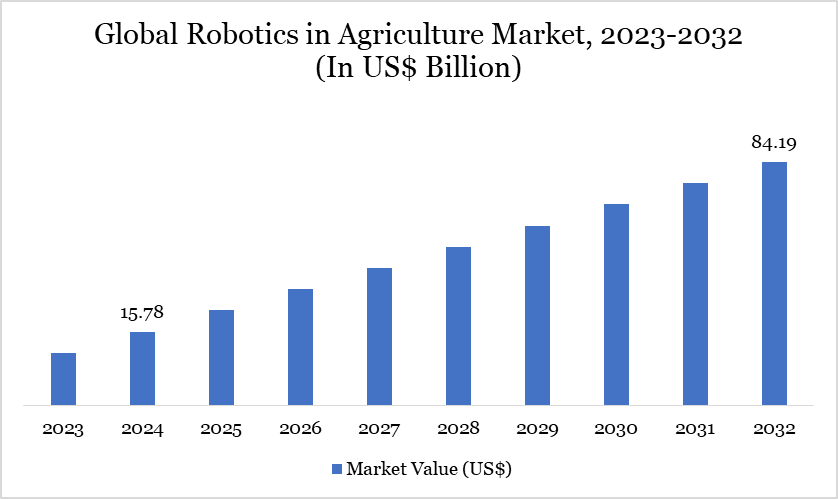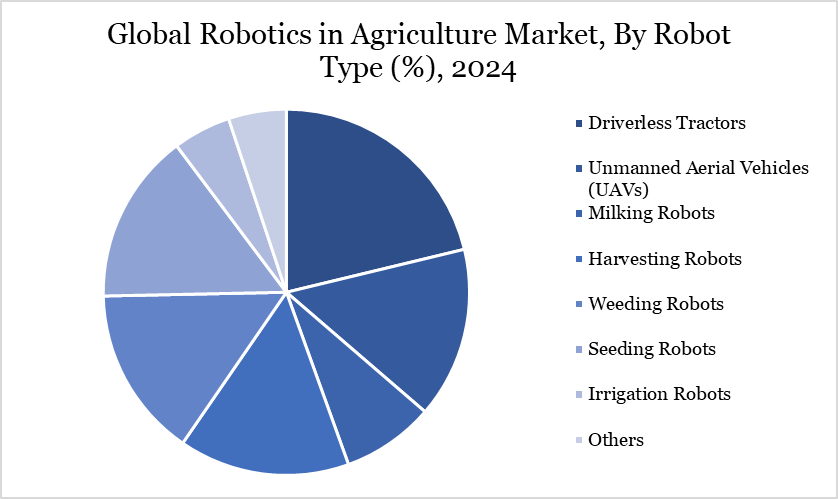Market Size
The Global Robotics in Agriculture Market reached US$ 15.78 billion in 2024 and is expected to reach US$ 84.19 billion by 2032, growing at a CAGR of 23.28% during the forecast period 2025-2032.
The robotics in agriculture market is expanding rapidly, driven by the need for automation to offset labor shortages, improve efficiency and support precision farming. Advances in AI and IoT, along with growing government support, are accelerating the adoption of autonomous equipment. This shift is enhancing productivity, reducing operational costs and promoting sustainable farming practices.
Robotics in Agriculture Market Trends
The integration of robotics in vertical farming is emerging as a transformative trend aimed at improving operational efficiency and reducing labor dependency. High labor costs and the need for consistent crop quality have prompted vertical farm operators to invest in automated systems for seeding, harvesting and monitoring.
For example, Robotics solutions, such as automated seed casters and harvesting units developed by Rooted Robotics, are enabling farms to scale operations while minimizing crop loss and increasing yield precision.
These systems not only reduce manual workload but also enhance consistency in planting density and harvesting accuracy, which are critical for profitability in space-constrained vertical farms. The deployment of AI-powered robots in such controlled environments is optimizing resource utilization and ensuring faster, cleaner processes. As vertical farming continues to scale, the adoption of affordable and modular robotic solutions will be key to improving return on investment and enabling long-term commercial viability.

For more details on this report, Request for Sample
Market Scope
| Metrics | Details | |
| By Robot Type | Driverless Tractors, Unmanned Aerial Vehicles (UAVs), Milking Robots, Harvesting Robots, Weeding Robots, Seeding Robots, Irrigation Robots and Others | |
| By Application | Field Farming, Dairy Management, Soil Management, Harvest Management, Irrigation and Water Management, Crop Monitoring and Others | |
| By Offering | Hardware, Software and Services | |
| By Farm Size | Small Farms (<10 hectares), Medium Farms (10–100 hectares) and Large Farms (>100 hectares) | |
| By End-User | Farmers, Agricultural Cooperatives, Research Institutions, Government Bodies and Agri-Tech Companies | |
| By Region | North America, South America, Europe, Asia-Pacific, Middle East and Africa | |
| Report Insights Covered | Competitive Landscape Analysis, Company Profile Analysis, Market Size, Share, Growth |
Market Dynamics
Labor Shortages and Rising Labor Costs
Widespread labor shortages and rising wage pressures are accelerating the adoption of robotics in agriculture. Farmers are increasingly turning to automation to manage labor-intensive tasks such as planting, harvesting and weeding. Robotics ensures timely operations, reduces labor dependency and improves overall farm efficiency. This trend is critical in addressing productivity challenges and minimizing crop losses. It also supports scalability in both traditional and high-tech farming systems.
For instance, in January 2025, John Deere launched its fully autonomous tractor, designed to tackle workforce shortages. The tractor uses GPS, AI and vision systems to operate independently with high precision. It allows farmers to reallocate limited labor to more strategic roles. This innovation highlights the industry's pivot toward autonomous solutions. Such technologies are expected to drive significant efficiency gains across global farming operations.
High Capital Investment and Ownership Costs
High capital investment and ownership costs are a significant barrier to adopting robotics in agriculture. Advanced systems require large upfront spending on equipment, installation and software integration. This deters small and mid-sized farms with limited budgets. The long payback period further complicates investment decisions. As a result, market adoption remains uneven across regions.
For example, Rooted Robotics is addressing this issue by offering affordable automation for vertical farms. Their low-cost seed caster, recently implemented at a farm in Denver, demonstrates cost-effective innovation. The solution reduces labor needs without heavy capital outlay. Such scalable models are gaining traction in the market. They enable broader adoption while minimizing financial risk.
Market Segment Analysis
The global robotics in agriculture market is segmented based on robot type, application, offering, farm size, end-user and region.

Rising Demand Drives Adoption of Autonomous Tractors in Modern Farming
Autonomous tractors have emerged as the dominant robot type in the agriculture robotics market, driven by their multi-functional capabilities and ability to reduce reliance on manual labor. These tractors are increasingly adopted in precision farming, where accuracy, consistency and efficiency are critical. With satellite guidance, remote operation via smartphones and AI integration, they enable round-the-clock fieldwork with minimal human intervention ideal for tackling labor shortages and boosting productivity.
For instance, Carbon Robotics launched the AutoTractor, a retrofitted autonomous farming system equipped with GPS, AI, radar sensors and LaserWeeder integration. Designed for 24/7 operations, it performs key ground preparation tasks without in-cab drivers. Its remote monitoring feature enables real-time operator intervention, addressing common adoption barriers such as operational disruptions.
Market Geographical Share
Accelerating AgTech Adoption: Rising Demand for Robotics in North American Agriculture
North America holds a significant share of the robotics in agriculture market, driven by labor shortages, rising wage costs and the need to enhance productivity and efficiency in farming operations. US and Canada are witnessing the rapid adoption of autonomous tractors, robotic harvesters, drones and precision farming technologies, particularly in large-scale commercial farms. Government support and investments in Agri-tech innovation are further accelerating the regional market growth.
For example, in September 2024, Niqo Robotics launched RoboThinner in North America to address growing labor challenges in lettuce farming. The AI-driven solution delivers 97% thinning accuracy and covers up to 7 acres per hour, boosting efficiency and yield quality. Designed for easy retrofit on existing tractors, it ensures seamless integration. With rapid ROI and strong adoption potential, it supports growers in key regions like Salinas and Yuma. This reflects North America's shift toward precision agriculture through robotics.
Sustainability Analysis
The integration of robotics in agriculture is significantly advancing sustainable farming practices by enhancing operational efficiency, resource optimization and environmental stewardship. Robotic systems reduce dependency on chemical inputs through precision application of water, fertilizers and pesticides, thereby minimizing environmental pollution and input waste.
AI-powered weeding robots and smart seeders help conserve soil health, reduce over-tillage and lower fuel consumption, supporting regenerative agriculture. Technologies such as robotic arms, autonomous tractors and vertical farming systems also contribute to higher yields with lower resource intensity, improving food security and profitability.
Major Global Players
The major global players in the market include Deere & Company, AGCO Corporation, Trimble Inc., Ecorobotix, Harvest Automation, Naïo Technologies, CNH Industrial N.V., Agrobot, Harvest CROO Robotics LLC. and KUBOTA Corporation.

Key Developments
- In March 2025, Carbon Robotics introduced Carbon AutoTractor, the first autonomous tractor solution with real-time remote supervision. Compatible with John Deere 6R and 8R tractors, it installs in under 24 hours and enables seamless switching between manual and autonomous modes. Integrated with the LaserWeeder, it improves operational efficiency by up to 20%, addressing labor challenges and enabling scalable, reliable farm automation.
- In February 2025, Yamaha Motor launched Yamaha Agriculture, Inc. to deliver autonomous equipment and AI-powered crop management solutions for specialty crops. Through the acquisitions of Robotics Plus and The Yield, the company aims to enhance precision farming and operational efficiency in key markets, aligning with its 2030 vision for robotics-driven sustainable agriculture.
Why Choose DataM?
- Data-Driven Insights: Dive into detailed analyses with granular insights such as pricing, market shares and value chain evaluations, enriched by interviews with industry leaders and disruptors.
- Post-Purchase Support and Expert Analyst Consultations: As a valued client, gain direct access to our expert analysts for personalized advice and strategic guidance, tailored to your specific needs and challenges.
- White Papers and Case Studies: Benefit quarterly from our in-depth studies related to your purchased titles, tailored to refine your operational and marketing strategies for maximum impact.
- Annual Updates on Purchased Reports: As an existing customer, enjoy the privilege of annual updates to your reports, ensuring you stay abreast of the latest market insights and technological advancements. Terms and conditions apply.
- Specialized Focus on Emerging Markets: DataM differentiates itself by delivering in-depth, specialized insights specifically for emerging markets, rather than offering generalized geographic overviews. This approach equips our clients with a nuanced understanding and actionable intelligence that are essential for navigating and succeeding in high-growth regions.
- Value of DataM Reports: Our reports offer specialized insights tailored to the latest trends and specific business inquiries. This personalized approach provides a deeper, strategic perspective, ensuring you receive the precise information necessary to make informed decisions. These insights complement and go beyond what is typically available in generic databases.
Target Audience 2024
- Manufacturers/ Buyers
- Industry Investors/Investment Bankers
- Research Professionals
- Emerging Companies